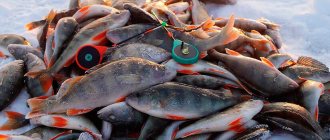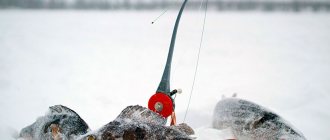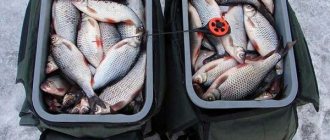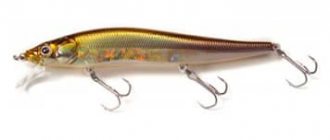Modern winter jigs - this is a combination of weight, material, color, shape, as well as various additives of artificial and natural origin.
At first glance, we can say that there is simply no simpler element of equipment, but this is not so; the choice of a specific jig is influenced by many factors: where you are going to catch, what kind of fish, and what the weather will be like. Over the course of their lives, experienced fishermen accumulate a whole set of all possible jigs, which are tested in practice and used in certain conditions.
The very first jigs were made of tin; this material is still popular today; winter baits made from this material are very small and light. They are very good at catching roach at depths of up to 2.5 meters with the addition of burdock larvae or bloodworms. Fishing with such a jig involves slowly lowering the bait into the bait column; the bite usually follows in the water column.
The next material from which winter jigs began to be made was lead and its alloys; such baits are well known to us because they are presented in stores in all possible variants. In addition, baits made from tungsten and its alloys are very popular among fishermen.
Gallery: winter jigs (25 photos)
Catching perch with a jig in winter (video)
We also recommend reading:
How to properly tie a jig to a fishing line Winter fishing for gudgeon with a jig How to catch taimen in winter Winter ice pick: purpose, types, making the tool yourself
Shape of jigs
It is probably impossible to describe all the known forms of jigs, there are so many of them, so we will focus on the most common ones.
- The simplest and most common form is a pellet and a drop. These winter baits are the most versatile and are suitable for catching almost any fish. It was with these jigs that winter fishing began for all of us.
- The next category of jigs are baits imitating the shapes of insects; they are more complicated and require the fisherman to have certain skills for proper play and well-balanced tackle.
- Dreissen are winter jigs that imitate the shape of a small mollusk. The peculiarity of this bait is that large fish usually bite on it, and the bites are more confident.
- The family of “devils” are baits with two, three or four hooks; especially good fishing is observed if you use artificial baits (beads, cambrics, colored foam rubber, etc.).
Collecting tackle with a jig
Fishing with a jig primarily involves selecting gear. It is good for the fisherman to know in advance where he will have to fish. For example, fishing in currents requires strong and coarse tackle.
Some aspects of preparing a winter fishing rod:
- When fishing with a jig, it is better to take a fishing rod with legs and a separate handle; light weight is not needed here.
- The reel must have a friction for catching a large specimen.
- The fishing line required is monofilament, with a diameter of 0.15-0.18 mm.
- The nod is long and bright, very sensitive.
- Select gear already on the spot; for winter fishing, “devil”, “uralka”, “ant” are suitable.
On the first ice, use a thick fishing line, since the fish are still active and often bite. In the middle of winter, the bite decreases, and accordingly, the fish are less active and careful - you have to change the fishing line to a thin one.
Half of your fishing success depends on the specific body of water. The fish, which were actively biting in one place, take breaks in another.
One of the essential components of winter fishing with this type of gear is the ratio of the weight of the bait and the depth of the fishing spot. For example, at a depth of up to 3 meters, the weight of the jig is recommended to be 0.3 grams. But at a depth of 5 meters, it is advisable to use tackle weighing 1.0 grams.
To assemble a winter fishing rod, you need to know: where we will fish (still water or current), what kind of fish we will catch, at what depth.
How to tie a jig correctly
The knots on the tackle must be reliable and at the same time must not spoil the fishing line. Although every fisherman has his own secrets in this matter.
Methods for tying jigs:
- Avoid excessive bending when tying knots.
- Before tightening the knot, it must be wet.
- The line is passed through a hole in the bait.
- The knot is tightened with the remaining free end.
There are some rules for attaching this bait to a fishing line:
- On a tackle with an eye, a regular knot is made - the fishing line is passed through the loop and wound around the hook, the fishing line is wound into the loop and tightened.
- On a bait with a hole, the line is passed through this hole. Then they wrap it around the shank of the hook and tighten the loop with the end of the fishing line.
- Tungsten lures are first knitted with an ordinary braided knot, then tied to the main fishing line “loop to loop”.
The most popular knots used are the figure eight and clinch.
To reliably knit knots, you need to practice in advance, because there will be no time to study at the fishing spot.
Jig color
Many anglers who make their own jigs leave the color of the metal from which they are made. Others, on the contrary, cover them with varnish or paint, copper plate them, paint on dots, eyes, specks; here everything directly depends on the angler’s imagination. And it’s even better if the fantasy is supported by knowledge and observations. We recommend learning how to catch tench in winter.
The only thing that is common to everyone when choosing the color of a jig is that in bright and clear weather it is better to fish with dark-colored jigs, and in cloudy weather winter lures of light colors perform well. Although we must remember that you need to select a jig by color or shade for a specific fish and on a specific body of water, because the same roach in different bodies of water may prefer completely different baits, under the same weather conditions.
Jig color
When choosing the color of the jig, take into account the environmental conditions, fishing time, water color, and depth. So, the lighter the water in the reservoir, the darker the jig should be.
Also, a dark bait should be taken if there is little snow on the ice and vice versa - the more snow, the lighter the jig.
In the morning, at shallow depths, you can fish with a shiny bait, while during the day, bait with a dull color is preferable.
Black jigs are considered the most versatile. For deep-sea fishing, a copper-colored bait is suitable, while after the 10 m mark the color of the jig is not at all important. For perch and roach, jigs of darkish shades (brown, dark green, purple) are used.











